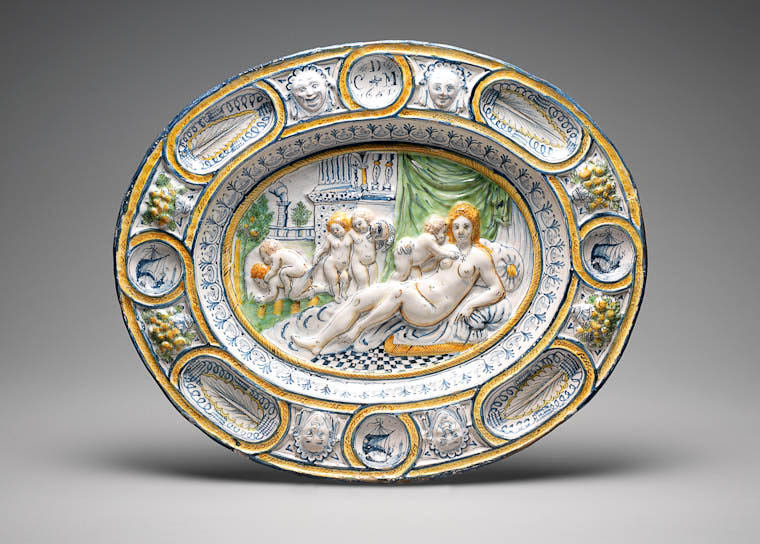Current Location: Gallery 27 (Glaisher)
Titles
Dish emblematic of Fecundity
Maker(s)
Pottery:
Pickleherring Pottery
(Probably)
Proprietor of pottery:
Newnham, Richard
Entities
-
Dish
- oval dish
- La Fécondité dish
Categories
Description
Tin-glazed and painted earthenware decorated in relief with a nude woman and five children emblematic of fecundity
Buff earthenware, press-moulded, tin-glazed, and painted in blue, green, yellow, and brownish-orange. Oval, with wide rim, and curved well. The rim is moulded in relief with alternately oval and circular depressions, separated by human masks, and vases of fruit and foliage, and the well with a reclining nude woman and five nude children, one of whom holds a dog. One of the circular depressions at top centre of the rim is nitialled and dated 'D/C M/1651 in blue.
Notes
History note: Purchased by Mortlock & Co, Oxford Street, London from an unknown vendor in 1893; purchased by Dr J.W.L. Glaisher from Mortlock & Co on 10 July 1907, for £75.
Legal notes
Dr J.W.L. Glaisher Bequest
Measurements and weight
Height: 6.1 cm
Width: 40.3 cm
Acquisition and important dates
Method of acquisition: Bequeathed
(1928-12-07)
by
Glaisher, J. W. L., Dr
Dating
17th Century, Mid
Commonwealth
Production date:
dated
AD 1651
Note
This dish is one of about forty-three dishes dated between 1633 and 1697 which are decorated in relief with a scene emblematic of Fecundity, showing a nude woman reclining on pillows on a mattress with five nude children to her left. The design was copied from a French lead-glazed earthenware dish, traditionally attributed to Bernard Palissy (c/ 1510- 1590), but probably made by one of his followers in Paris, Fontainebleau, or Rouen A French merchant, Claude Beaulat, living in London, seems to have specialized in importing ceramics from France, could have been the channel through which dishes of this design reached London. (See Documentation, Britton, and Denis-Dupuis)
The Pickleherring, Montague Close, and Rotherhithe potteries in Southwark were operating in 1651 when this dish was made, but it seems likely that it was made at Pickleherring. The sailing ship in the circular depressions, links the dish to seven others with ship motifs in their borders. One of these, at Colonial Williamsburg (inv. 19698-123) is decorated with the arms of the Broderers' Company and the initials N/RE and date 1661, probably for Richard and Elizabeth Newnham. Richard was the proprietor of the Pickleherring pottery, Southwark from 1647 until his death in 1684, and there is therefore a strong likelihood that this group of Fecundity dishes was made there. See also C.1410-1928.
School or Style
Mannerist
People, subjects and objects depicted
Components of the work
Decoration
composed of
high-temperature colours
( blue, green, yellow, brownish-orange)
Whoel
Length 48.8 cm
Materials used in production
buff
Earthenware
Tin-glaze
Techniques used in production
Press-moulding
: Earthenware, press-moulded, tin-glazed, and painted in blue, green, yellow, and brownish-orange high-temperature (metallic oxide) colours; many pinholes in the glaze on the reverse
Tin-glazing
Inscription or legends present
- Text: D/C M/1651
- Location: On front
- Method of creation: Painted
- Type: Inscription
References and bibliographic entries
Related exhibitions
Identification numbers
Accession number: C.1422-1928
Primary reference Number: 71979
Old object number: 2699
Stable URI
Audit data
Created: Saturday 6 August 2011
Updated: Monday 25 March 2024
Last processed: Tuesday 15 July 2025
Associated departments & institutions
Owner or interested party:
The Fitzwilliam Museum
Associated department:
Applied Arts




